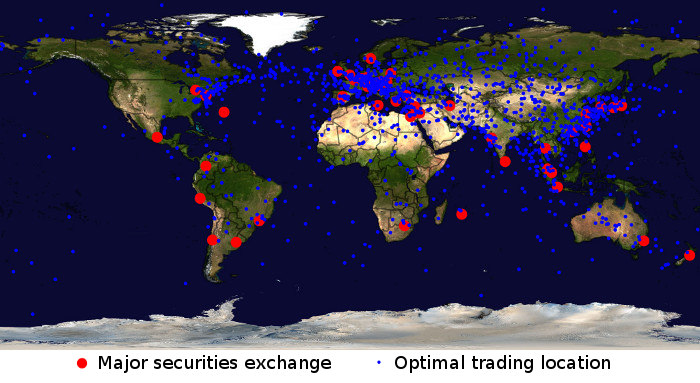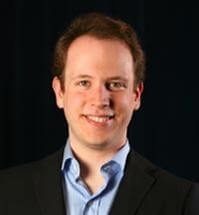News
 Alex Wissner-Gross says the future isn’t coming fast enough.
Alex Wissner-Gross says the future isn’t coming fast enough.
Consider the predictions of the 1950s, he says. Here we are, ten years past the millennium, and what do we have to show for ourselves?
“We’re supposed to have ubiquitous space travel and exploration. We’re supposed to have flying cars. We’re supposed to have ocean cities, atomic vacuum cleaners... These technologies never panned out.”
The limiting factor, he says, is energy—energy generation and energy storage. We can build tiny robots with sophisticated AI, but when we demonstrate them in the lab, like us, they’re still tethered to the wall by a power cord.
Wissner-Gross (A.M., Ph.D. '07) has two great passions. The first is this conviction that inefficiencies in infrastructure shouldn’t prevent innovation. The second is the concept of programmable matter, where the physical world of heat, chemistry, and magnetism, for example, intersect with computation.
While preparing to write his doctoral thesis on programmable surfaces four years ago, he drew up a matrix of every possible way of converting one type of physical signal—e.g. a fluid flow, an electrical signal, or a thermal signal—into every other type. The chart brought together aspects of many seemingly disparate fields, providing not just a unifying perspective, but also a useful tool.
“It turns out that a lot of the entries in that matrix have been filled by very high-impact research in the past,” says Wissner-Gross. As part of his thesis, he used gaps in the matrix to identify areas of potential new research, several of which he has explored as a postdoctoral fellow at Harvard’s School of Engineering and Applied Sciences (SEAS) and now as a research affiliate in the MIT Media Laboratory.
His recent research has run the gamut from physics, his native subject, through Earth science, computer science, and mathematics, ending up—of all places—in finance.
Like most SEAS affiliates, he doesn’t let pesky things like academic boundaries get in his way. As an undergrad at MIT, Wissner-Gross earned three simultaneous bachelor’s degrees in physics, electrical engineering, and mathematics, graduating at the top of his class in engineering.
“I could see relatively early on in my academic career that the natural course, if I didn’t take preemptive action, would collapse me down to a narrow specialty,” he explains. “It’s why I did the triple major at MIT, and it’s why I studied physics at Harvard.”
With guidance from his thesis adviser, Tim Kaxiras, the John Hasbrouck Van Vleck Professor of Pure and Applied Physics at SEAS, and with the financial support of the Hertz Foundation, Wissner-Gross found that he was able “to float a few inches above the floor so that I could get over bumps and over boundaries.”
This past year, Wissner-Gross was a Ziff Environmental Fellow at the Harvard University Center for theEnvironment (HUCE) under the guidance of Matt Welsh, Gordon McKay Professor ofComputer Science at SEAS, who is well known for his work on wirelesssensor networks and distributed computing.
At HUCE, Wissner-Gross widened his view of programmable surfaces to the planetary scale. As our civilization deploys computers more and more densely across the surface of the planet, he asked, at what point does it become important to consider the environmental and energy impacts of that?
Then, as the path of his research veered towards finance, he wondered, “What happens when we put so much programmable hardware all over the Earth that it actually affects the way information propagates and the way finance is done?”
In a paper published November 1 in the journal Physical Review E, he offers responses to these questions. The idea behind “Relativistic Statistical Arbitrage,” which he co-wrote with Cameron Freer (Ph.D. ’08), an instructor in pure mathematics at MIT, is that high-frequency financial trading now happens so quickly that the data network it relies on is holding it back.
Consider a simple form of hedge fund trading: when the price of a stock on Wall Street is higher than average, and the price of a very similar stock in London is lower than average, a clever trader might want to sell the first stock and buy the second, on the assumption that the prices will quickly settle back toward each other.
The problem is that it takes about 50 milliseconds—eons for today's transactions—for the price data to cross the Atlantic through fiber-optic cables. It turns out that even data traveling at the speed of light is not fast enough when the other trading center is 3,000 miles away and decisions need to be made immediately. By the time the information reaches its destination, the opportunity to sell and buy has long gone.
The problem is amplified for statistical arbitrage, a more complex type of hedge fund trading in which portfolios of hundreds of securities are monitored and traded at once.
With additional computers between trading centers—think of them as trading posts between nations—the data might only have to travel half as far before a decision could be made. Wissner-Gross and Freer derived a formula to determine the optimal locations of these intermediaries and plotted them on a map. The result is a much denser, more globally accessible network and more efficient financial trading (up to a point; this is where the “relativistic” part comes in. For more details, read the paper).
The finding presents what Wissner-Gross calls “a beautiful example, probably the first example” of an economically justifiable reason to blanket the Earth (including its oceans) with computers.

Wissner-Gross and Freer's research produced a map of the optimal trading locations worldwide. Image courtesy of Alex Wissner-Gross.
His ultimate motivation is to “wake up the world in a physical sense and broaden the intersection between computers and everything else.” The environmental concerns, however, are very real. After all, he spent time at HUCE for a reason.
While he is fascinated by a future where everything around us could be programmable, he also acknowledges the need to balance such computational ubiquity with innovations in green computing.
His first start-up company, Enernetics, evaluates and certifies the “green” credentials of websites around the world, encouraging energy-conscious Internet usage.
“If you believe that we’re going to convert more and more of our physical world to being hardware for computers,” he says, “then it follows that we’re going to start allocating more and more of our civilization’s energy budget to powering those computers.”
Like the optimists of the 1950s, Wissner-Gross has his own vision for the future: “Someday we may find ourselves living in a world that is so rich with computation that it becomes indistinguishable from running our lives as software on top of a computer."
Rethinking Tech Transfer
Alex Wissner-Gross '07 (Ph.D.) believes that “technology transfer” is a misnomer. He has some advice for what young researchers can do to make sure their academic work finds applications outside the lab.
"A lot of people have this misconception that when you transfer a piece of basic research or applied research into commercial products and start your company, that you’ve solved some problem in an academic lab and now you’re going to put it in a shiny wrapper and start selling it to people. And that’s not what happens.
“What actually happens is not that solutions get transferred; it tends to be that problems get transferred. I think this is one of the reasons why ‘technology transfer’ itself is something of a misnomer. It should be ‘problem transfer.’
"What actually tends to happen… is that an academic will identify a problem that’s worth solving, and will solve it, but the solution won’t be perfect. Then, the solution and the problem get transferred out into some sort of company or industry or licensed, and—this is the part that doesn’t often get publicized—once it’s over that wall and in industry, the solution that had been developed gets thrown out the window.
"The problem will get re-solved, and a much better, much more practical solution will be developed that works, is scalable, and solves a real human need.
“If there wasn’t some real human problem that it was designed to solve initially, then you’re stuck commercializing a solution in search of a problem.”
The bottom line:
“Make sure from the beginning that you’re baking real problems into your work so that at the end of the day, if you’re successful in commercializing it, you can afford to throw away any solutions that you came up with earlier.”
Cutting-edge science delivered direct to your inbox.
Join the Harvard SEAS mailing list.
